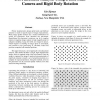Free Online Productivity Tools
i2Speak
i2Symbol
i2OCR
iTex2Img
iWeb2Print
iWeb2Shot
i2Type
iPdf2Split
iPdf2Merge
i2Bopomofo
i2Arabic
i2Style
i2Image
i2PDF
iLatex2Rtf
Sci2ools
PICS
2001
2001
Dot Placement Analysis Using a Line Scan Camera and Rigid Body Rotation
Printer manufacturers design print heads and halftone patterns to result in specific types of image characteristics. Many image quality artifacts are a result of differences in actual dot placement from intended dot placement. Quantifying dot placement variations can be a complex endeavor requiring image capture at high magnification for adequate sampling. Large dot fields are imaged in pieces, which requires re-stitching of images prior to assessment, and extensive post processing to calculate actual dot positions compared with intended positions. This paper discusses a novel approach to dot placement analysis. This method includes a single, high magnification image, which is captured using a line-scan camera. Once the image is captured, the image is analyzed using principles of rigid body rotation to match a set of actual dot positions to a template of expected positions. Using this method, errors in dot placement can be assessed rapidly without errors that stem from image stitching...
| Added | 31 Oct 2010 |
| Updated | 31 Oct 2010 |
| Type | Conference |
| Year | 2001 |
| Where | PICS |
| Authors | Yair Kipman, Kate Johnson |
Comments (0)

